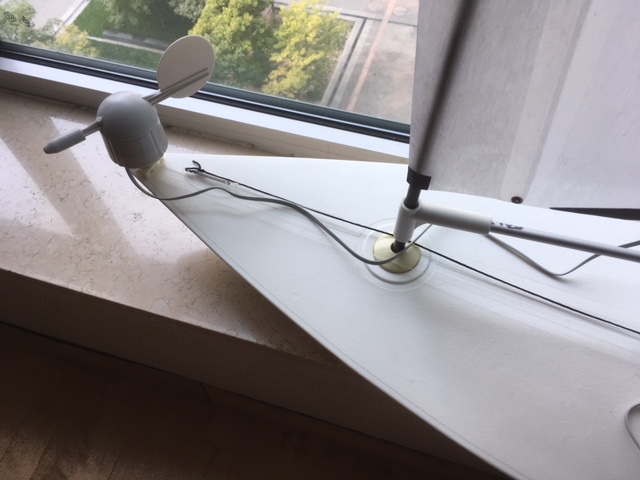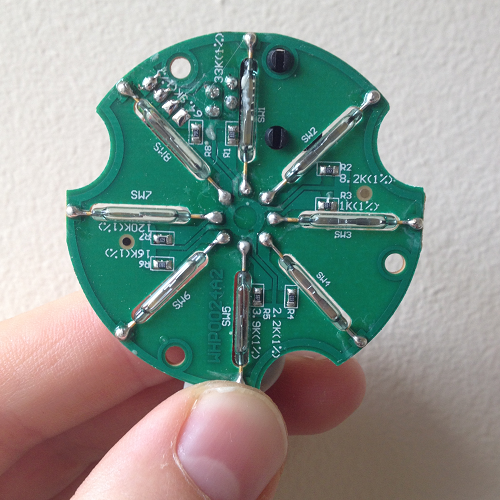I didn’t understand “ACRO” mode. The boom is always almost 90 degrees in fly down wind. And if you increase the “SAIL_ANGLE_IDEAL”, the boom will always be close to 0 degrees in headwinds.Was it planned?
ACRO mode is manual rate steering and automatic sail trimming.
SAIL_ANGLE_IDEAL parameter defines the angle of attack of the sail to the wind, so a angle of zero would result in the sail being set parallel to the wind vane. As you increase this parameter the sail will sheet in relative to the wind. This only has a effect if the boom can reach the angle, downwind the sail is limited by the SAIL_ANGLE_MAX parameter.
Thank you for the additional explanation.
By default SAIL_ANGLE_IDEAL is 25. When the course angle of the wind is greater than 115 degrees, the boom will always be released for the maximum of “SAIL_ANGLE_MAX”. Is that right? At 90° off the wind, a craft is on a “beam reach” and the optimal angle for the boom should be about 45 degrees, not 75. At 135° off the wind, a craft is on a “broad reach” and practical angle for boom usually less than 90 degrees, not SAIL_ANGLE_MAX,
This is correct for SAIL_ANGLE_MAX of 90 and SAIL_ANGLE_IDEAL or 25. 90 + 25 = 115. As you say these are the defaults.
This sail angle is trimmed to apparent wind, a beam reach is defined by true wind of 90 deg. The sail will sheet in to the apparent wind so you will end up at a angle less than 75. I think the apparent wind could easily come round 20 or 30 deg leaving the sail trimmed at 45 - 55 deg relative to the center line.
You need to tune the value of SAIL_ANGLE_IDEAL for each vessel . I think as we have it now works reasonably well, there is of course always room for improvement.
You need to keep tension on the sheets for a drum type winch. Good luck and keep trying.
What type of boat are you testing this on?
Yes, the true wind deviates from the course of the boat more than the apparent wind. But on the starting line, which is parallel to the true wind, the speed of the boat is still very small and the apparent wind will be also 90 degrees. And the angle of the mainsail will be set by the controller to 90-25 = 65 degrees. Therefore, in "ACRO " mode the boat very slowly accelerates.
You can always increase the SAIL_ANGLE_IDEAL. This will result in the sail being sheeted in more. If you find a value that works better we could consider changing the default.
Only increase SAIL_ANGLE_IDEAL will not be enough. First, the increased SAIL_ANGLE_IDEAL is needed only when the boat speed is close to 0. Second, on sharp courses to the wind, another SAIL_ANGLE_IDEAL may be optimal.
I’ve tried racing in Acro mode. Its not meant for racing. There are times you luff with the sheets out to keep the boat moving slow and then accelerate before the gun goes off. SAIL_ANGLE_IDEAL works pretty good. What the filters are set at can make a big difference.
Hello all,
I am new here, first post really.
If its a better place to post this, please moderator, just move it.
Spring is coming and looking forward to a sailing season 
I just recently learned there has been two great developments at ardupilot;
support for sailboats! and to run Ardupilot on the smaller OpenPilot Revo boards!
I am really excited to try this out and to contribute if possible, maybe by beta testing if needed.

I have an RC Laser sailer with a Revo and a gps running on the LibrePilot sw. That means no support for sail or wind vanes etc. At the moment, I am waiting for the new Ardurover V3.5.0 Stable to become available and install it. It was announced yesterday so I think its will soon be changed from V3.4.2 in the Mission Planer Install Firmware screen.
Meanwhile, would like to discuss Wind vanes.
I have already got a wind direction unit and wind speed sensor unit.
They are part of the Raspberry PI education program.
They may or may not be possible to use them with the current software 3.5.0.
They are low cost, easy to get hold of, well documented and with source code, how to implement. But they are also maybe not be the best solution, as is, to a small sailboat, but they can be modified.
Anyway, here are some specs
. picture of wind vane 
. manual
Argent Weather Sensor 80422_datasheet.pdf (47.6 KB)
. the wind vane at 15 USD : https://www.argentdata.com/catalog/product_info.php?products_id=201
. the wind speed at USD : https://www.argentdata.com/catalog/product_info.php?products_id=175
. the code thing: https://github.com/raspberrypilearning/sensing-the-weather
Sorry, for such a long post.
Bit overambitious at this point I guess.
Will focus on getting the wind vane to work, but according to the wiki, it seems need to have increasing voltage as the direction of the wind comes from 0 to 90 degrees etc. Thats not how its set up at all.
Thoughts are welcomed 
Regards
Karl
… also agree with others view that the location of the wind vane is better on mast top than on deck.
but for dreams this unit might come later
. low weight
. no moving parts
. both wind speed and direction
. have wireless connection to the FC, no cables needed
. solar powered
. have compass and accelerometers to compensate for tilting
. very expensive though
https://calypsoinstruments.com
great to see some interest in the Sailboat support. Welcome
Unfortunately that type of wind sensors is not accurate enough in this case. It is activated as a magnet passes over 8 reed switches. Its sort of a ‘points of the compass’ wind direction sensor, so you only get accuracy of ± 22.5 deg, might be just good enough for reaching and down wind but not for upwind. looks like a nice housing though, maybe you could fit a potentiometer or rotary hall effect in the housing.
Unfortunately the type of wind speed sensory you currently have is also unsupported, however I think we could borrow some code from the rpm sensor library and add support fairly easily.
Certainly there are better sensors, as you say all a quite expensive but no reason they shouldn’t work, really depends how open the manufactures are with there protocol documentation.
The race is on to build third (as far as i know) Ardurover sailboat !
Thank you Peter.
This will save time spent on that windvane, thanks.
I see there are quite some experience here on other types
Any particular unit that stands out, that is supported by V3.5.0?
I can get some to try out.
For those fancy small units from calypso instruments,
they have the source open for developers, several apps use it already: https://calypsoinstruments.com/page/developers
also have a developer’s manual: https://calypsoinstruments.com/website/static/Dev_manual_Ultrasonic_Portable_1.8.pdf
I think most have used this bourns potentiomiter on a diy vane. I posted some cad for 3D printing the one i made somewhere in the thread. Also in this thread somewhere is a link to a hall effect sensor that may work better but as far as i know has not been tested in the field.
We have not really got past using cheap as possible sensors to just to prove the code works yet, but more will come in time. Nice to see the calypso units publish all the protocols, there cheaper wired one implements a NEMA protocol, i think there was some discussion of NEMA protocols for ehco sounders.
Yes I understand, one step at the time, good strategy.
I think I will get both units and try them. Thanks.
This weekend I downloaded and flashed the ArduRover V3.5.0 on to one of my Openpilot Revo boards. Following the wikis worked well in the end.
Noticed my Mission Planner, Install Firmware screen still show ArduRover V3.4.2, maybe I misunderstood this thought it would show the new stable version. Anyway, first I got the beta version from the download site and flashed the hex file with bootloader. Then realizing that is probably not the latest one I want and downloaded from Stable directory the file named ‘ardurover.apj’, since the hex files did not want to upload to board (using MP). I think its okay. Not sure though since there is not an option number 89 for Main Sail in the SERVO3_FUNCTION list. I just entered 89, seems to work.
RC input, Rudder and ‘winch’ movements, Compass, GPS and Volt/Current sensors all work. Its like magic 
Will try to find a way to test if the logics work, cant get a gps fix here.
You will have to update mission planner also to get the latest parameter descriptions.
Some time ago I was checking out Hardy Lau blog post describing a DIY ultrasonic wind vane. Prototype II resembles commercial wind sensors in use usually sold at over $500-$1k.
The overall design and working principles are well understood and replicable, the accuracy very high especially when coupled with an environmental sensor to correct sound speed formulas taking into account temperature and humidity. The tricky part is calibration of parameters in a wind gallery.
Thanks Peter,
Now the Main sail etc is displayed after updating the MP.
Also the two potentiomiter units are ordered.
I will try to fit them in to the housing I already got. It has some nice bearings and connectors but needs to be balanced like a propeller - at the moment they are very nose heavy.
acrro
Regards to the testing of logics, I am not able to switch from manual to Acro mode - it just tell me it failed to switch modes.
My plan is while having the WNDvn TYPE set to 1 - direction of wind at armed, then move boat around and observe what will happen with the main sail.
Karl